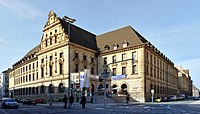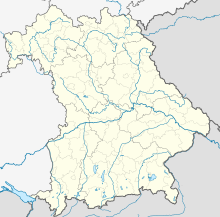Nuremberg Transport Museum

Entrance of the museum.
|
|
| Established | 1899 |
|---|---|
| Location | Nuremberg, Germany |
| Coordinates | 49°26′44″N 11°04′28″E / 49.445556°N 11.074444°ECoordinates: 49°26′44″N 11°04′28″E / 49.445556°N 11.074444°E |
| Type | Transport history museum |
| Website | www.dbmuseum.de |
The Nuremberg Transport Museum (Verkehrsmuseum Nürnberg) is based in Nuremberg, Germany, and consists of the Deutsche Bahn's own DB Museum and the Museum of Communications (Museum für Kommunikation). It also has two satellite museums at Koblenz-Lützel (the DB Museum Koblenz) and Halle (DB Museum Halle). The Nuremberg Transport Museum is one of the oldest technical history museums in Europe.
In February 2007 the official name of the DB Museum became the Company Museum of the Deutsche Bahn AG (Firmenmuseum der Deutschen Bahn AG). It is a milestone on the European Route of Industrial Heritage (ERIH).
The forerunner of the present-day DB Museum was opened in 1899 as a royal Bavarian railway museum and it is therefore the oldest railway museum in Germany. Today it is a company museum belonging to the Deutsche Bahn and portrays, amongst other things, the history of the railways. The present building was built in 1925.
On 1 July 1996, the Deutsche Bahn AG (DB AG) took over the museum from the Deutsche Bundesbahn for the symbolic purchase price of one deutschmark. At the same time Dr. Jürgen Franzke, previously head of the Museum of Industrial Culture (Museums Industriekultur) in Nuremberg, was appointed as the museum's chief. The DB AG planned at that time to invest 6 million DM up to the museum's centenary year.
In the displays of historical railway vehicles are the following important exhibits:
Some of the original vehicles are not in the museum itself, but in the wagon shed situated in the open area belonging to the museum on the opposite side of the street. The museum also owns a range of historical vehicles that can be used for special rail services.
A further attraction of the museum is its collection of 160, 1:10 scale models occupying 1000 square metres of the museum. These models have been built over the years since the end of the 19th century and are very finely detailed. The first were made in 1882 by apprentices of the Royal Bavarian State Railways (Königlich Bayerische Staats-Eisenbahnen).
...
Wikipedia

